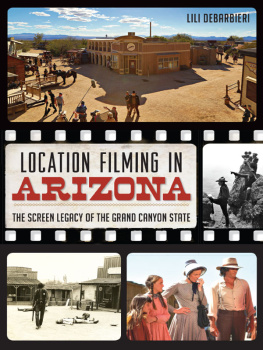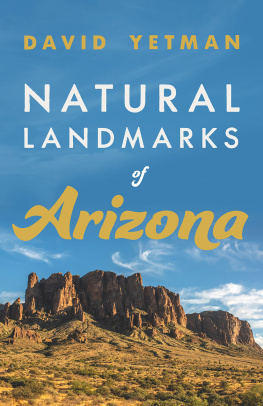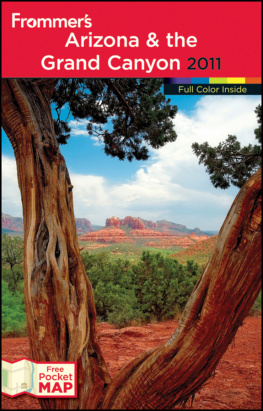

Published by The History Press
Charleston, SC 29403
www.historypress.net
Copyright 2014 by Lili DeBarbieri
All rights reserved
First published 2014
e-book edition 2014
ISBN 978.1.62584.519.1
Library of Congress Cataloging-in-Publication Data
DeBarbieri, Lili.
Location filming in Arizona : the screen legacy of the Grand Canyon state / Lili DeBarbieri.
pages cm
Includes bibliographical references and index.
Includes filmography.
print edition ISBN 978-1-62619-063-4
1. Motion picture industry--Arizona--History. 2. Motion pictures--Setting and scenery--Arizona. I. Title.
PN1995.67.A7D43 2014
791.43025--dc23
2014000736
Notice: The information in this book is true and complete to the best of our knowledge. It is offered without guarantee on the part of the author or The History Press. The author and The History Press disclaim all liability in connection with the use of this book.
All rights reserved. No part of this book may be reproduced or transmitted in any form whatsoever without prior written permission from the publisher except in the case of brief quotations embodied in critical articles and reviews.
CONTENTS
PREFACE
When the credits of a film roll, I wait patiently to the end, intrigued to find out where the movie shot. Movie-related tourism and sitesMonument Valley, where Forrest Gump ends his cross-country journey; North Carolinas Chimney Rock State Park, which appears in The Last of the Mohicans; and downtown Tucsons Chicago Music Store, featured memorably in Martin Scorseses Alice Doesnt Live Here Anymore with its charismatic yellow-and-black signagebring added meaning and dimension to these locales. You are transported through the filmmakers version and interpretation of a place at a particular moment in time. Movie travel allows a viewer to see a place anew through the emotions and tone that the film inspires, whether suspense, horror, adventure, drama or wonder. Suddenly, movies filmed on location in Arizona seem to be popping up everywhere. On television, there is an endless parade of films and showsincluding Little House on the Prairie, A Kiss Before Dying, Cant Buy Me Love and Trafficand so many were filmed in and near my hometown of Tucson alone.
With respect to moviemaking, just what are locations? Locations are simply the places or sites at which a movie, television show or commercial film. More importantly, they establish the locale, the overall look, texture and the emotional and visual pulse of a film, shared Timothy Flood, a Tucson-based locations manager. Often a viewers first and last image, the location can be more memorable and expressive than even the stars or script of the filmit can be a secondary character.
In Arizona, a location may be a cactus forest, a lovely stretch of highway scenery, towering granite cliffs or urban environments. Locations are nearly synonymous with landscape in Arizonathe rolling grasslands of Santa Cruz and Cochise County, the forest and red rock country of the north, with many of the states city-based historical locations in a precarious existence.
There is an intense amount of public fascination with the decades between the 1930s and the 1960s. Because of this, moviegoing audiences are, in turn, fascinated with the pop culture of that time, most fully captured and represented in films. The western genre during filmmakings iconic golden age coincided with this time. Yet the films made on location in Arizona encompass the entire span of possible genres. The body of the states filmmaking history is moving, memorable and truly magnificent. Although by no means an exhaustive portrait of Arizonas vast film and television history, the following chapters will introduce you to the states influential and significant films that represent historic and contemporary eras of filmmaking in Arizona.
ACKNOWLEDGEMENTS
My deepest gratitude and appreciation go to the following organizations and individuals who assisted me tremendously in every aspect of writing this book:
Christine Aeurbach, Apacheland Movie Ranch, Arizona Film and Media Coalition, Arizona Historical Society, Arizona State Library, Arizona State Parks, Phil Bradstock, Veronica Burgess, Peter Catalonotte, Frances Causey, Timothy Flood, Emil Franzi, Jay Gammons, Shannon Gans, Shelli Hall, Jennifer L. Jenkins, Michael Kucharo, Marty Miller, Navajo Nation, Michael Ohrling, Old Tucson Studios, Oracle Historical Society, Jeffery Patterson, Phoenix Convention and Visitors Bureau, Phoenix Film Office, Pima County Library, Pinal County Historical Society, Prescott Film Office, Quartsite Historical Society, Philip Rauso, Sedona Chamber of Commerce, Sedona Film Office, Sedona Historical Society, Sharlot Hall Museum, Bob Sharp, Lisa Sharp, Bob Shelton, Yvonne Taylor, Marshall Trimble, Tubac Historical Society, Tucson Film Office, Tucson Historic Preservation Foundation, Visit Prescott, Visit Tucson, Victoria Westover, Tony Whitman, Jack Young, Yuma Convention and Visitors Bureau and Yuma Film Office.
A special thank-you goes to my fianc, Theodore Manno, for all his support.
INTRODUCTION
WERE NOT IN CALIFORNIA ANYMORE
When I dont feel in the mood for painting I go to the movies for a week or more.
Edward Hopper
Since the nineteenth century, thousands of films, television movies and shows have been made in the state of Arizona, an incredible contribution to world film history. The states cities, small towns and countryside have been the settings for countless westerns, comedies, dramas, action adventures, love stories and science fiction films, to name a few genres, and have all been featured on the big and small screens. Long before Hollywood was established, filmmaking in the state began as early as 1898. With the availability of moving image cameras and long-distance railroad travel, Arizonas incomparable scenery and Native American culture began to attract filmmaking pioneers eager to capture this vast, unexplored visual frontier. Path sent cameramen around the world to capture actuality films, explained Jennifer L. Jenkins, film historian at the University of Arizona, of the French film production company. Their device, the cinmatographe, could both shoot and project, so they could offer programs of same-day local footage as well as scenes from other, exotic places. It was during these early filmmaking years that cinmatographe screenings were reported in the Arizona Territorys mining camps.
With the expansion of the Southern Pacific Railroad in the early twentieth century, itinerant filmmaking crews such as the Philadelphia-based Lubin company began to travel by railroad around the country. It was an exhilarating time in the film world on the brink of talking pictures that would change the movie experience forever. It was during this era that legendary director Cecil B. DeMille arrived in Prescott, Arizona, to begin filming a western, The Squaw Man. A blizzard sabotaged his plans, so DeMilles entourage continued farther west to a Los Angeles suburb then called Hollywoodland.
Although Arizona was passed over by the legendary director for the area that would eventually become Hollywood, its place in world film history would soon be firmly established. Through its locations, including Old Tucson Studios, as well as its natural and cultural resources, the states film community would become a significant force in the history of film to rival even California. Arizona has been considered an almost ideal place for filmmaking for its beautiful climate and diverse settings of every human and natural environment imaginable. From Sonoran desert to mountains, lakes, forests, grasslands, ranches, farms, natural geologic wonders, sand dunes, dense urban areas, highways, dirt roads and roadside attractions, the scenery of the states public and private lands has been immortalized time and time again for moviegoers. The rich iconography of western filmmaking owes much to the incredible wonderland of the Southwest. From early silent films and talkies to the Technicolor extravaganzas to modern studio and independent films, this diversity has been utilized and showcased to perfection. Indeed, Arizona became a last resort for filmmakers seeking this unspoiled frontier scenery that could accurately reflect the West at the turn of the century. The most famous example is the Rodgers and Hammerstein classic
Next page






